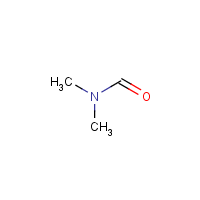Dimethylformamide
Agent Name
Dimethylformamide
CAS Number
68-12-2
Formula
C3-H7-N-O
Major Category
Solvents

Synonyms
DMF; DMF (amide); DMFA; Dimethyl formamide; Dimethylamid kyseliny mravenci [Czech]; Dimethylformamid [German]; Dimethylformamide; Dimetilformamide [Italian]; Dimetylformamidu [Czech]; Dwumetyloformamid [Polish]; Formamide, N,N-dimethyl-; Formic acid, amide, N,N-dimethyl-; N,N-Dimethyl formamide; N,N-Dimethylformamide; N,N-Dimethylmethanamide; N,N-Dimetilformamida [Spanish]; N-Formyldimethylamine; U-4224; [ChemIDplus] UN2265
Category
Amides (<C10)
Description
Colorless to pale-yellow liquid with a faint, amine-like odor; [NIOSH]
Sources/Uses
Used as a solvent in acrylic fiber spinning, textile dyeing, and paint stripping; also used in coating, printing, gluing, and pharmaceutical manufacturing; [http://www.cdc.gov/niosh/90-105.html] Used as a solvent for vinyl resins; [Kanerva, p. 1786] Used in synthetic leather manufacturing; [JOEM 2004;46:729-736]
Comments
Liquid causes first degree burns on short exposure; [CHRIS] Contact dermatitis reported in epoxy resin handler; Also can provoke alcohol-induced flushing; [Kanerva, p. 1786] DMF is toxic to the liver. [Reference #1] May cause liver injury and jaundice; [ICSC] Animals exposed to single lethal doses have CNS depression, anesthesia, convulsions, and coma. [HSDB] In the list of 15 chemicals classified as potentially fetotoxic even if MAK value observed; [Reference #2] “Detailed reviews of these data indicate adverse effects on reproductive and teratogenic endpoints, but only at maternal toxicity.” [ACGIH] See "Carcinogenicity of some industrial chemicals," Volume 115. [IARC, News Release, 23 February 2016] The BEI for Total N-methylformamide (NMF), which represents the sum of N-methylformamide (NMF) and N-(hydroxymethyl)-N-methylformamide (HMMF), is intended to protect almost all workers from liver damage due to exposure to N,N-dimethylformamide (DMF) by all routes of exposure." [ACGIH: BEI Documentation]
Biomedical References
Exposure Assessment
BEI
N-Methylformamide in urine = 30 mg/L at end of shift; N-Acetyl-S-(N-methylcarbamoyl)cysteine in urine = 30 mg/L at end of shift at end of workweek; [TLVs and BEIs]
Skin Designation (ACGIH)
Yes
TLV (ACGIH)
5 ppm
PEL (OSHA)
10 ppm
MAK
5 ppm
IDLH (NIOSH)
500 ppm
Excerpts from Documentation for IDLHs
Basis for original (SCP) IDLH: The chosen IDLH is based on the statements by Clayton et al. [1963] that rats survived a 4hour exposure to air saturated with dimethylformamide vapor [Smyth and Carpenter 1948] and inhalation of saturated vapors for 6 hours was lethal [Haskell Laboratory]. A.D. Little reports that the saturated concentration at 20 C is 3,550 ppm. Because exposures to rats for 4 hours were at saturated concentrations, 3,500 ppm is chosen as the IDLH. . . . Human data: None relevant for use in determining the revised IDLH.
Vapor Pressure
3.87 mm Hg
Odor Threshold Low
0.47 ppm
Odor Threshold High
100 ppm
Lethal Concentration
LCLo (rat) = 5,000 ppm/6 hr
Explanatory Notes
Flash point = 58 deg C, closed cup; [ACGIH] Odor threshold from AIHA; VP from HSDB;
Half Life
Whole body: 4 hours; [TDR, p. 551]
Reference Link #2
NFPA
high ambient temp required
ERPG-1
2 ppm
ERPG-2
100 ppm
ERPG-3
200 ppm
Adverse Effects
Neurotoxin
Acute solvent syndrome
Hepatotoxin
Occupational hepatotoxin (principal effect)
Dermatotoxin
Skin burns
IARC Carcinogen
Probable (2a)
ACGIH Carcinogen
Confirmed Animal
Diseases, Processes, and Activities Linked to This Agent
Diseases
Occupational diseases associated with exposure to this agent:
Processes
Industrial Processes with risk of exposure: